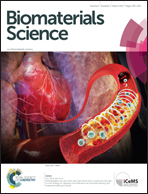Biodegradable vascular stents with high tensile and compressive strength: a novel strategy for applying monofilaments via solid-state drawing and shaped-annealing processes
Abstract
Monofilaments such as those consisting of polyamide (PA), polydioxanone (PDS), and poly(vinylidene fluoride) (PVDF), have been commonly used in various industries. However, most are non-biodegradable, which is unfavorable for many biomedical applications. Although biodegradable polymers offer significant benefits, they are still limited by their weak mechanical properties, which is an obstacle for use as a biomaterial that requires high strength. To overcome the current limitations of biodegradable monofilaments, a novel solid-state drawing (SSD) process was designed to significantly improve the mechanical properties of both PA and poly(L-lactic acid) (PLLA) monofilaments in this study. Both PA and PLLA monofilaments exhibited more than two-fold increased tensile strength and a highly reduced thickness using SSD. In X-ray diffraction and scanning electron microscopy analyses, it was determined that SSD could not only promote the α-crystal phase, but also smoothen the surface of PLLA monofilaments. To apply SSD-monofilaments with superior properties to cardiovascular stents, a shaped-annealing (SA) process was designed as the follow-up process after SSD. Using this process, three types of vascular stents could be fabricated, composed of SSD-monofilaments: double-helix, single-spring and double-spring shaped stents. The annealing temperature was optimized at 80 °C to minimize the loss of mechanical and physical properties of SSD-monofilaments for secondary processing. All three types of vascular stents were tested according to ISO 25539-2. Consequently, it was confirmed that spring-shaped stents had good recovery rate values and a high compressive modulus. In conclusion, this study showed significantly improved mechanical properties of both tensile and compressive strength simultaneously and extended the potential for biomedical applications of monofilaments.



 Please wait while we load your content...
Please wait while we load your content...